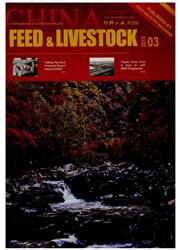

 中文摘要:
中文摘要:
研究旨在调查市售花生粕中胰蛋白酶抑制因子和皂苷的含量范围。采集山东省不同厂家的21批次花生粕.分别采用酶联免疫法试剂盒和比色法-酶标仪测定其内胰蛋白酶抑制因子与皂苷的含量。结果显示:花生粕中胰蛋白酶抑制因子P5~P95置信区间的含量范围为0.94~4.80mg/g,平均含量为(2.41±1.21)mg/g,浸提与压榨工艺下花生粕中胰蛋白酶抑制因子的平均含量分别为(2.78±1.32)mg/g和(2.29±1.20)mg/g。花生粕中皂苷P5~P95置信区间的含量范围为5.78~9.01mg/g,平均含量为(7.20±0.18)mg/g,浸提与压榨工艺下花生粕中皂苷平均含量分别为(6.63±0.82)mg/g和(7.38±1.38)mg/g。压榨法与浸提工艺下的花生粕相比,胰蛋白酶抑制因子含量低,皂苷含量高。同时发现,花生粕中胰蛋白酶抑制因子和皂苷含量之间无相关性,且不同花生粕中皂苷含量均高于胰蛋白酶抑制因子的含量。本研究将为饲料企业及研究者研究花生粕中的抗营养因子含量及其检测方法提供参考。
 英文摘要:
英文摘要:
In order to investigate the concentration range of major ANFs (trypsin inhibitors and saponins) in peanut meals, 21 batches of available peanut meals were collected in different factories for determining the concentrations of trypsin inhibitors and saponins. The concentrations of trypsin inhibitor were analyzed by Enzyme-link Immunosorbent Assay (ELISA). The method followed the instruction of the test kit. Method of microplate spectro photometer was applied to the saponins test instead of UVVIS spectrophotometer. Results showed that take P5 to P95 for confidence interval, the trypsin inhibitor concentration range in peanut meal was 0.94-4.80 mg/g, and the average level of (2.41±1.21) mg/g. The concentration range of saponin was 5.78-9.01 mg/g and the average concentration of (7.20±0.18) mg/g. In addition, under two kinds of oil-producing process of extraction and squeezing process, the average concentration of trypsin inhibitor were (2.78± 1.32) mg/g and (2.29± 1.20) mg/g, respectively and the average concentration of saponins were (6.63±0.82) mg/g and (7.38±1.38) mg/g, respectively. Compared with the extraction technology, the mean concentration of trypsin inhibitor in peanut meals processed by pressing was lower, and that of saponin was higher. At the same time, this study found that there was no correlation between the concentration of trypsin inhibitor and saponin in peanut meal, and the concentrations of saponins were higher than trypsin inhibitors. This research analyzed the concentration of trypsin inhibitors and saponin in peanut meal collected from Shandong Province, which will attract more feed companies and researchers focus on the testing method and concentration of ANFs in peanut meal.
 同期刊论文项目
同期刊论文项目
 同项目期刊论文
同项目期刊论文
 期刊信息
期刊信息
